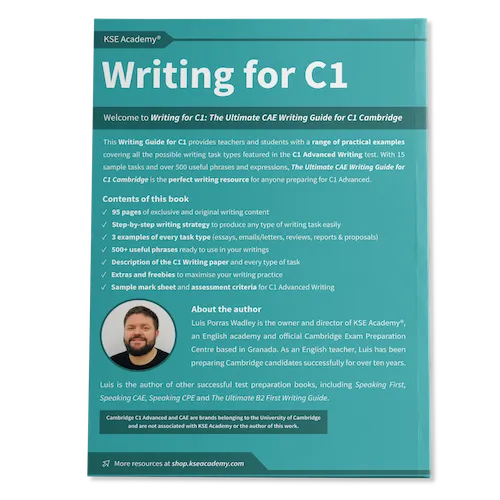
How to Write an Essay for C1 Advanced (CAE)
In this article, I show you how to write an essay for Cambridge CAE Writing. In addition, I bring you a guide to C1 Advanced (CAE) Writing that will help you improve your writing.

Table of contents
As I’m sure you already know, Cambridge exams have several papers (Reading, Writing, Use of English, Speaking and Listening), and each of these components is divided into different parts. In this post, I want to focus on Writing Part 1 of the C1 Advanced, that is, how to write an Essay for the CAE. Because, remember, C1 Writing Part 1 will always be an essay 🙂
What are the parts of the C1 Advanced Writing?
The C1 Advanced (CAE) Writing, as we have already seen in another article, has 2 parts, and for each one you will have to write a text according to the exercise instructions. What you should know is that there is a limited range of text types that you may be asked to write in each part, so let’s see:
- Writing Part 1: In this part you will always have to write an essay, and you will have no other options to choose from. That’s why it is really important that you pay attention to this article and learn how to write an essay for C1 Advanced to the best of your ability.
- Writing Part 2: In this part, you will have 3 options to choose from, and the types of Writing you may be asked are the following:
- Formal letter/email
- Informal letter/email
- Review
- Report
- Proposal
Each writing task you do should be between 220 and 260 words long, approximately, and, as they are different types of writing, you should take into account the peculiarities of each one in terms of structure, register, grammar and vocabulary, etc.
So let’s start with the one that concerns us in this article: Essays!
What is an essay?
An Essay is a text of opinion in which we analyse a topic, a situation or a problem from different points of view or by considering several points or solutions to the problem. In each of the paragraphs, we deal with each point and express different facts, considerations and opinions.
Now that we know what an essay is, let’s look at how to write an essay and its characteristics.
How to Write an Essay for CAE Writing
Here are the main characteristics of a C1-level essay so that you can keep them in mind when writing:
- Purpose: With an essay, what we do is evaluate a topic, situation or problem that is of some interest or controversy (e.g. teenage mobile phone use). Often, the Writing activity is set as a task that takes place after a class debate. In an exam, you will have to imagine the debate for yourself (duh!).
- Tone and register: As it is a text on a serious or controversial topic, the Essay is always written in a formal context, so we must use an objective tone. Furthermore, the linguistic register should always be formal, avoiding common words such as things, stuff, get, etc.; contractions (can’t, don’t, won’t, etc.); or expressions that may sound informal.
- Structure: Like all writing tasks, an essay has a fairly well-defined structure, although it is not 100% fixed and immovable. To begin with, we can choose to give it a title or not, but, personally, I find it more appropriate to write an Essay with a title. Have you ever seen a text published without a title? Probably not. As for the body of the essay, it should be divided into the following paragraphs: introduction, point 1, point 2 and conclusion. In other words, in general, a Cambridge C1 Essay should have 4-5 paragraphs.
- Opinion: This is where we have the most leeway when writing an essay for C1. There are many ways of expressing your opinion in an Essay, so you should choose the one that best suits your Writing approach. What I usually recommend, however, is that you remain impartial throughout the whole text and only express your opinion at the end, in the last paragraph, as a conclusion. As always, the most important thing is that you justify everything you say in your writing and that your conclusion answers the main question of the assignment.
- Coherence and progression: Coherence is essential in all Writings, but especially in the essay. As it is a supporting and argumentative text, you cannot write unconnected sentences and paragraphs; the ideas must follow a logical and well-connected order, using connectors appropriate to C1 level, in this case. Furthermore, the reader must perceive a logical progression of paragraphs, without losing the thread of what you are trying to argue. Otherwise, when they get to the last paragraph, they won’t know what you are talking about and our writing will have failed catastrophically.
CAE Writing Essay Example
Now that we are familiar with the main features of an essay for Cambridge Advanced (CAE) Writing, let’s look at a sample essay at C1 level, both the sample instructions and a possible answer.
C1 Essay Instructions
In the picture below you can see an example from the Cambridge website.

From these instructions, we must always extract the essentials:
- Topic: facilities which should receive money from local authorities
- Points to deal with:
- museums
- sports centres
- public gardens
- Opinions we can use:
- «Museums aren’t popular with everybody!»
- «Sports centres mean healthier people.»
- «A town needs green spaces – parks are great for everybody.»
- Essential instructions:
- Address only 2 of the 3 points given.
- Answer and justify the main question («to which facility is it most important that local authorities give money«).
- Justify your answer («giving reasons in support of your answer«)
- Use your own words («use your own words as far as possible«)
Sample C1 Essay
According to the task model outlined above, we can approach out writing with the following structure:
- Introduction
- Point 1 (museums)
- Point 2 (sports centres)
- Conclusion
Although it is not set in stone, you will normally get 4 paragraphs. So now let’s look at an example Essay for CAE Writing:
| Funding local facilities When it comes to deciding which facilities should receive funding from local authorities, two options that often come to mind are museums and sports centres. Both of these serve important roles in their respective communities and can bring many benefits to their users. On the one hand, museums can be seen as a valuable cultural resource, offering the opportunity to learn about the history and heritage of a place. In addition, they can be a significant economic driver, attracting tourists and generating income for the local area, which is always desirable. On the other hand, sports centres provide a space for people to engage in physical activity and maintain good health. Not only can they serve as a social hub, bringing people together, but they can also promote a sense of community. Furthermore, for young people, in particular, sports centres can provide a positive outlet for energy and a place to develop teamwork and leadership skills. Ultimately, the decision on which facility to prioritize may come down to the specific needs of the community. However, I would personally choose to prioritize funding for museums. While sports centres are certainly important and provide many benefits, I believe that museums offer a unique opportunity for learning and cultural enrichment that cannot be found elsewhere. Additionally, the economic benefits of museums, particularly for smaller communities, cannot be overlooked. |
At first glance, we can see that this Essay for C1 has an introductory title and 4 paragraphs (introduction, museums, sports, conclusion). In addition, if we read the text carefully, we can see the following aspects:
- Title: The title perfectly summarises for the reader the topic to be covered in the text. Sometimes, a title in the form of a question such as «Which facilities should receive funding from local authorities?» can be a good idea, although I always prefer more concise titles.
- Paragraphs: Paragraphs are well defined not only linguistically and semantically, but also visually, which is very important. In addition, they have a very clear purpose that the reader can immediately identify:
- Introduction: introduces the topic and mentions the two options we are going to discuss in the following paragraphs.
- Museums: Discusses the benefits of museums and the benefits of investing money in them.
- Sports centres: Discusses the benefits of sports centres and the consequences of investing money in them.
- Conclusion: In a very clear way, museums are seen as the ones that should receive the investment for certain reasons that are well justified.
- Connectors: Connectors are used that clearly define the coherence and progression of the text.: on the one/other hand, in addition, ultimately, however, while, etc.
- Language:
- We do not use contractions or catch-all words.
- We use expressions appropriate to C1 level:
- When it comes to
- comes to mind
- valuable cultural resource
- heritage
- generating income
- desirable
- engage in physical activity
- social hub
- positive outlet for energy
- Etc.
- Grammar is also advanced (E.g.: Not only can…, but they also…)
In short, this is a good example of an Essay for CAE Writing. It should be noted, however, that this writing is written to simulate a strong C1 level, perhaps without necessarily going into a C2 level.
Will I be penalised if I write less than 220 or more than 260 words?
This is the most typical question in this part of the exam and the answer is: yes and no. Let me explain. The assessors won’t count the words and penalise you according to the number of words only. There is a rumour going around among students and teachers that for every 10 words they take away X points, but this is not true. However, if you have gone over 260 words by 50 or 100 words, or more, there is probably some content that is not relevant to the assignment, and that is penalised. Likewise, if you write less than 220 words, you are probably missing important information or you are not covering it in the detail required by the task instructions.
For this reason, I always recommend going over 20 words at most. That way you won’t lose points if your assignment covers the required topics and points. 🙂
The best guide for C1 Advanced Writing with examples and useful expressions
Although I will be publishing more articles explaining how to do each type of task for C1 Advanced, the best thing you can do to get plenty of information and practice is to buy the official KSE Academy guide to CAE Writing. In this guide you will find the following:
I hope you found this post useful. If you did, don’t forget to share with your friends and family. 🙂
I’ll see you in the next post. Until then, don’t forget to keep smiling!

